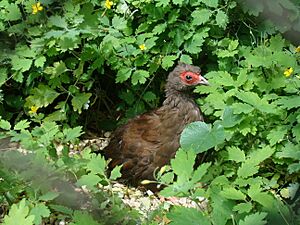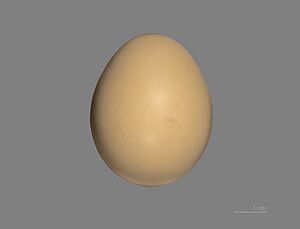Edwards's pheasant facts for kids
Quick facts for kids Edwards's pheasant |
|
|---|---|
 |
|
| Male | |
 |
|
| Female, Zoo Bojnice, Slovakia | |
| Conservation status | |
| Scientific classification | |
| Genus: |
Lophura
|
| Species: |
edwardsi
|
The Edwards's pheasant (Lophura edwardsi) is a special kind of bird. It belongs to the Phasianidae family, which includes pheasants. This bird lives only in the tropical forests of central Vietnam. It was named after a French bird expert, Alphonse Milne-Edwards, and was first described in 1896.
These pheasants are about 58 to 65 centimeters long. They have bright red legs and red skin on their faces. Male Edwards's pheasants are mostly blue-black with a cool crest on their heads. Females are a plain brown color. When they are alarmed, they make a sound like puk!-puk!-puk!.
There are two main types of Edwards's pheasants. The most common type has a white crest and a white upper tail. Another type, sometimes called the Vietnamese pheasant, has some white tail feathers. Scientists think these differences might be because of small, isolated groups of birds.
Sadly, the Edwards's pheasant is now considered Critically Endangered. This means it is very close to disappearing from the wild. Its numbers have dropped because of deforestation (forests being cut down) and hunting. Also, chemicals used during the Vietnam War harmed their habitat.
Today, there are likely only 50 to 249 of these birds left in the wild. Most of them are the common type. However, they are doing well in zoos and special breeding programs. These programs help protect the species outside of its natural home. No one has seen a wild Edwards's pheasant since the year 2000. Groups like the World Pheasant Association are working to find and protect them.
Contents
About Edwards's Pheasants
How They Were Discovered
The Edwards's pheasant was first seen by scientists in 1896. Years later, another pheasant, the Imperial pheasant, was found. It was later discovered to be a mix of the Edwards's pheasant and the Silver pheasant. This shows how unique the Edwards's pheasant is.
What They Look Like
Edwards's pheasants are about 58 to 65 cm long. Their tails are quite long too. Males have tails around 24-26 cm, and females have tails about 20-22 cm. Males are heavier, weighing about 1100 grams. Females weigh around 1050 grams.
Male birds are completely black with a blue shine on their feathers. Female birds are a chestnut-brown color and do not have a crest.
Where They Live
Edwards's pheasants live only in central Vietnam. They have been found in four different provinces there. They prefer to live in evergreen forests. These forests often have many palm trees and patches of bamboo.
The birds like to hide in the low plants. Female pheasants dig their nests on the ground in these forests. Edwards's pheasants do not usually move to different areas. They can stay in their homes even during winter.
Edwards's Pheasant Behavior
Sounds They Make
Male Edwards's pheasants make a wing-whirring sound. Their alarm call is a low, rough "uk uk uk uk uk." Sometimes, it sounds like a sharp "puk puk puk puk puk."
What They Eat
Scientists don't know much about what Edwards's pheasants eat in the wild. This is because they are rarely seen.
However, pheasants in zoos, like at the Denver Zoo, eat a special diet. This diet includes mealworms, chopped fruit, and green vegetables. They also get food made for game birds.
How They Have Babies
Edwards's pheasants usually lay eggs between March and May. To find a mate, male birds puff out their chests. They also vibrate their wings and raise the feathers on their backs.
Females can start having babies after they are two years old. They are usually most fertile when they are 4 or 5 years old. On average, a female lays about 4 to 7 eggs at a time.
The females build their nests well hidden on the ground. They often use plant bits and bamboo to cover the nest. The female sits on the eggs for about 20 to 22 days. The male stays nearby to guard the nest. The eggs are round and a light pink color with cream spots. Young pheasants are mostly chestnut-brown.
Protecting Edwards's Pheasants
The Edwards's pheasant is on The IUCN Red List of Threatened Species. In 2018, it was listed as Critically Endangered. This makes it one of the most endangered types of Galliformes (a group of ground-feeding birds).
Their population is still shrinking. There are only about 50 to 249 adult birds left. Any groups of these birds are likely very small and getting smaller. They have not been seen in the wild since the year 2000.
Many things have caused their numbers to drop. These include intense hunting and trapping. Their homes have also been lost due to logging and clearing land for farms. Chemicals used during the Vietnam War also damaged their habitat.
There are some nature reserves where these birds might still live. These include Khe Nuoc Trong, Bac Huong Hoa, Phong Dien, and Ke Go. In 2015, a special plan was made to help protect this species.
The Phong Điền Nature Reserve was set up to protect the Edwards's pheasant. This happened after the bird was seen there again in 1996. In 2018, a photo of a dead female Edwards's pheasant was taken in a nearby area. This was the first proof of a wild Edwards's pheasant in almost 20 years. It gives hope that the species might still be living in the reserve.



